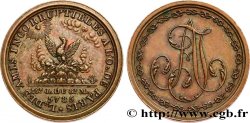fjt_534381 - FREEMASONRY Amicitiam Renovare - Fondateur Louis Albert GAYRIN n.d.
Not available.
Item sold on our e-shop (2021)
Price : 90.00 €
Item sold on our e-shop (2021)
Price : 90.00 €
Type : Amicitiam Renovare - Fondateur Louis Albert GAYRIN
Date: n.d.
Metal : bronze
Diameter : 38 mm
Orientation dies : 12 h.
Weight : 26,74 g.
Edge : Lisse + corne + bronze
Puncheon : corne BRONZE
Catalogue references :
Predigree :
Exemplaire provenant de la Collection JCT
Obverse
Obverse legend : L :. AMICITIAM RENOVARE.
Obverse description : Dans un phylactère, au dessous un globe terrestre rayonnant, deux colonnes J et B, sur un socle équerre, compas, truelle, maillet, niveau de salomon sur fond de rameaux d’accacia. A l’exergue : SCIENCE / AMOUR / VERITE. Signé : GUITTON.
Obverse translation : Renouer l’Amitié.
Reverse
Reverse legend : * AUX HOMMES DE BIEN LES FRANCS MACONS RECONNAISSANTS *.
Reverse description : Dans un cercle perlé en trois lignes plein champ : GAYRIN LOUIS ALBERT / FONDATEUR / 5952.
Commentary
Louis Albert GAYRIN est un peintre né à Bordeaux en 1911 et décédé à Paris en 1971. Membre fondateur de la loge du Grand Orient de France, elle même fondée en 1952. De nombreuses oeuvres ont été vendues aux enchères. Louis Albert Gayrin a fait partie de l’école néo-cubiste et l’ensemble de son oeuvre porte la marque de l’influence de Braque. Sa peinture post-cubiste, est vivement colorée.
Inédit, exemplaire non répertorié dans l’ouvrage de Monsieur Labouret.
Inédit, exemplaire non répertorié dans l’ouvrage de Monsieur Labouret.








 Report a mistake
Report a mistake Print the page
Print the page Share my selection
Share my selection Ask a question
Ask a question Consign / sell
Consign / sell
 Full data
Full data



